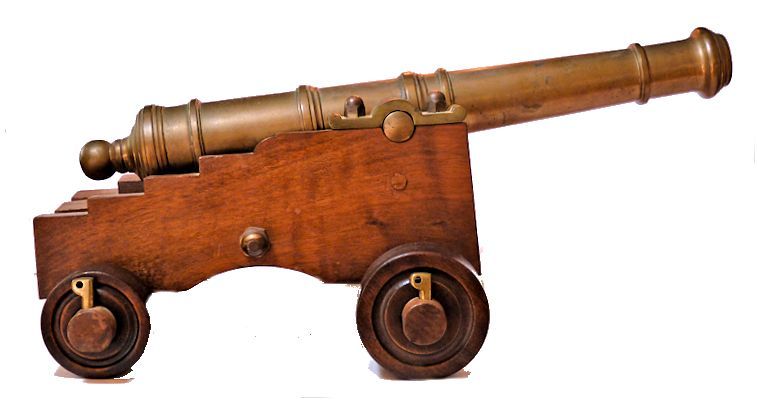This is one of the finest antique
miniature signal
cannons we have offered.
This signal cannon is an example of those used by the Royal
Navy in the 18th and 19th Centuries.
The workmanship is of exemplary making it a rare
find.

Presented
is a finely made
cast bronze signal cannon replicating the type that was
used by the British Royal Navy during the 18th and early 19th
Centuries on the gun decks of Ship’s of the Line. Notice that
it’s design exactly follows the drawing above from the Royal
Armoury archives of a 17th Century cannon.
Miniature cannons like this
were made for presentation, or as a foundry replica of an
example of its products or for actual use as a signal cannon. It
has no foundry markings, but it does have a large embossed
cartouche of an intricate cypher intertwined around the shank
of a fowled anchor with the British Royal Crown above.
The greenish patina ranges with
minor variation over the cannon’s length and hardware. The
original carriage is made from Mahogany and has well made bronze
hardware. The bore is free to the touch hole, and shows no
evidence of being fired.
The design
has the
characteristics of the most noteworthy examples of Royal Navy
cannons of the 18th and early early 19th Centuries which
include:
-
-
-
-
-
-
Six reinforcing
bands
=”left”>
=”left”>
This cannon is being offered
for display only and should not be fired unless inspected by a
gunsmith.


The trunnions are located in
the center of the tube and date the design to after
1725. The introduction of the Cronstedt system
coincided with the trunnions being located at the mid
level of the inner chamber. Before this they had been
placed below the
centerline.
DIMENSIONS:
Cannon
Length
overall 22 1/4″
Length
barrel
20
1/2″ Bore
1 3/64″ or 1.04 Cal
Maximum diameter of
tube 3 1/2″ at 1st
ring
2″
Weight of
cannon 20 pounds
Carriage 11″
W x 13 3/8″
L x 8″ high =”msonormal”>
=”left”>

ROYAL
CARTOUCHE: The image of the intricate cartouche above
the picture of the back of the cannon shows a fowled anchor
under the royal crown with the initials intertwined with
the anchor’s shank. It is clear
that the “R” on the right designates
Rex for king, but the one on the left is confusing because of its tail. It might be a “G” for
George III (1738 – 1820).
PROVENANCE: The cannon was
acquired in the normal course of business from a
seller who said it was from a Palm Beach Estate that
had a relationship with the Royal
family.


CONDITION: The naturally aged patina
has an even green cast over the length of the barrel and the
trunnion caps as well as the axle pins. The touch hole
is free to the bore. The wood carriage is in
excellent condition with only a few dings and light
scratches. There a few other minor marks of age as
expected. There are no mold marks or
inscriptions other than the fowled anchor and crown
as described in detail in the first
paragraph.



